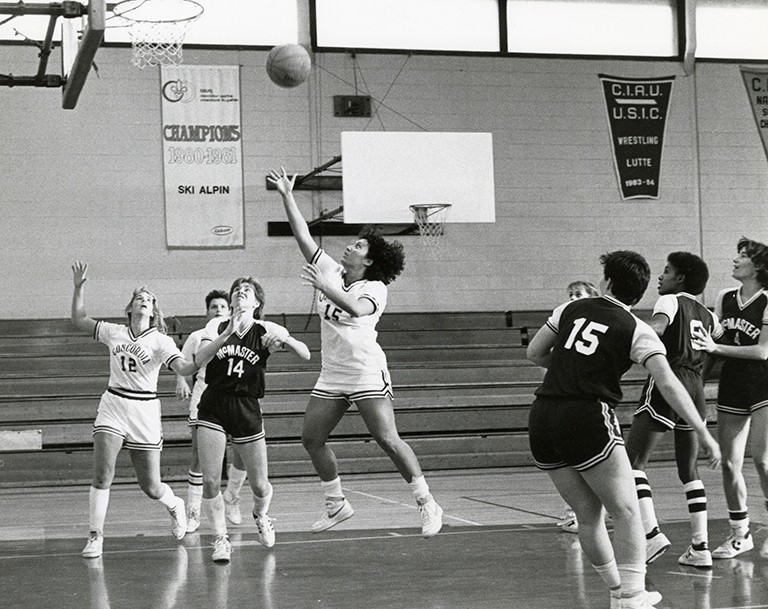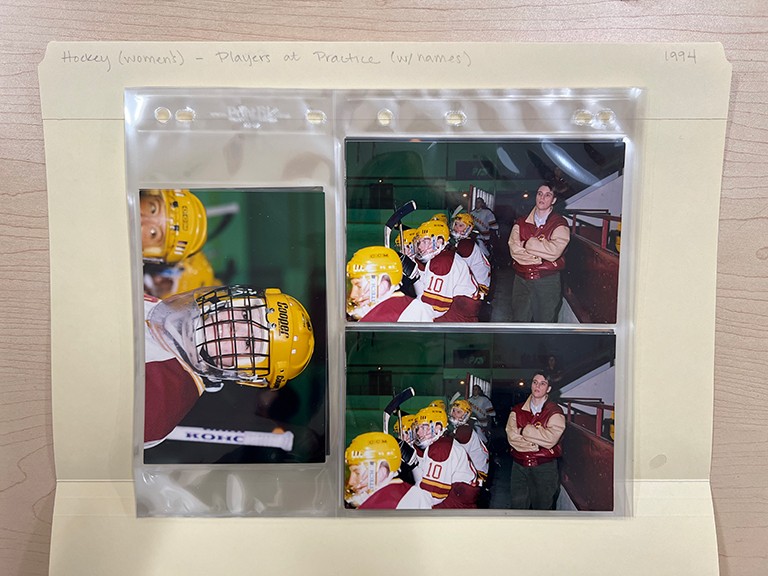‘Organizing and archiving video and photos of our successes will help the legacy of the Stingers live on’
 The Concordia Stingers women’s basketball team in action in 1986.
The Concordia Stingers women’s basketball team in action in 1986.
Concordia archivists are currently processing a large collection of university Recreation and Athletics materials spanning back to the 1950s. These historical records of the Concordia Stingers include everything from vintage uniform designs and team photographs through the decades, to video recordings capturing some of the teams’ earliest games.
The collection includes record transfers that Concordia’s Records Management and Archives (RMA) first received in 2018. These span 20 boxes of photographs and documents, and approximately 30 terabytes of data containing over half a million “born-digital” files — that is, files originally created in a digital format.
Handling these physical and digital materials requires different approaches, but the end goal is the same: to organize, preserve and make the materials accessible to researchers, students and anyone else interested in Concordia’s history.
Liam Mahoney, BFA 13, multimedia communications coordinator for the Concordia Stingers, notes that many student athletes have achieved “incredible success” representing Concordia. Archiving their achievements is necessary to preserving the department’s history.
“As time passes, organizing and archiving video, photos and news clippings of our successes will help the legacy of the Concordia Stingers live on as the memories are passed down to the generations that follow,” he says.
Preserving historical materials like these is the primary responsibility of RMA. With help from archives practicum student Natasha Fisher, the project is well under way.
 A box from the Recreation and Athletics acquisition, before 24-hour processing.
A box from the Recreation and Athletics acquisition, before 24-hour processing.
The process of processing
How does an archivist “process” a collection like this one? Processing physical materials encompasses everything, from start — a messy box of loose photographs — to finish — a sorted, curated, preserved collection in an acid-free box. A single archival box can take up to 24 hours to process.
First, archivists categorize materials into folders and gently tuck each photograph inside a protective sleeve. Some detective work is required to determine the year, team, sporting event and individuals in each photo to categorize the images correctly. Duplicate or unrelated materials are securely disposed of along the way.
Next, high-definition scans are made of selected photographs and documents using Concordia’s digital preservation lab. The scans are uploaded to the RMA Internet Archive for access and long-term preservation.
Audiovisual materials like 16 mm film, VHS tapes, Betamax and audio reels are also digitized in-house with help from Concordia’s Visual Collections Repository.
Outdated formats can pose a problem for archivists: for example, VHS tapes can start deteriorating after only 10 years.
“Ensuring the longevity of archival material is a major challenge for archivists,” explains Julie Daoust, acting university archivist.
“Technology is evolving quickly, and we need to adapt to ensure that we are able to consult and visualize material, particularly audio-visual material.”
 Recreation and Athletics photos, after processing.
Recreation and Athletics photos, after processing.
Processing digital materials: a whole different ball game
Picture four external drives packed with 4 terabytes of photos, documents, and video clips from 2016 to 2020 Stingers teams. The archives team came up with a game plan: retain the most important historical materials, as storage space can be expensive. In this case, “important” was defined as:
- photos and video footage from priority games, such as playoff, championship, tournament matches and special events
- photos of teams, players, priority gameplay and recognition events
An effort was also made to preserve the archival record of traditionally under-represented sports and athletes. Each file was individually reviewed and sorted into digital folders, then uploaded to the university’s digital preservation platform, Archivematica.
Some hidden treasures
- “Guacamole”: a skit performed by Concordia Stingers football team
- Stingers men’s basketball and alpine skiing footage from the 1960s*
- Loyola vs. Carleton 1960s football game*
- Stingers team photos through the decades, all sports
- Top plays of 2016, all sports, photos — coming to YouTube soon
*Materials originated from a 1990s acquisition but digitized alongside the RMA-2022-20 collection.
What’s next for these materials?
Preserving materials that contain records of Concordia students, staff and faculty — and their achievements — is the purpose of the university’s Records Management and Archives. Processing materials like the Recreation and Athletics files opens up potential for research, exhibitions and educational initiatives.
These records are intended to offer insight into the evolution of varsity and intramural sports, to document student engagement in physical activities over the years, and to showcase the Stingers’ role in shaping Concordia’s student culture.
The materials mentioned in this article are available on Concordia’s AtoM website.
Check out the digitized recreation and athletics materials on Concordia’s Internet Archive.
Digitized video footage is available on the RMA YouTube channel.




